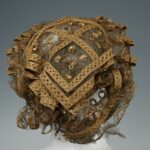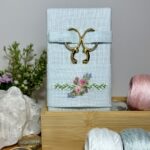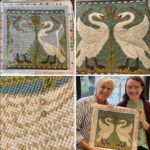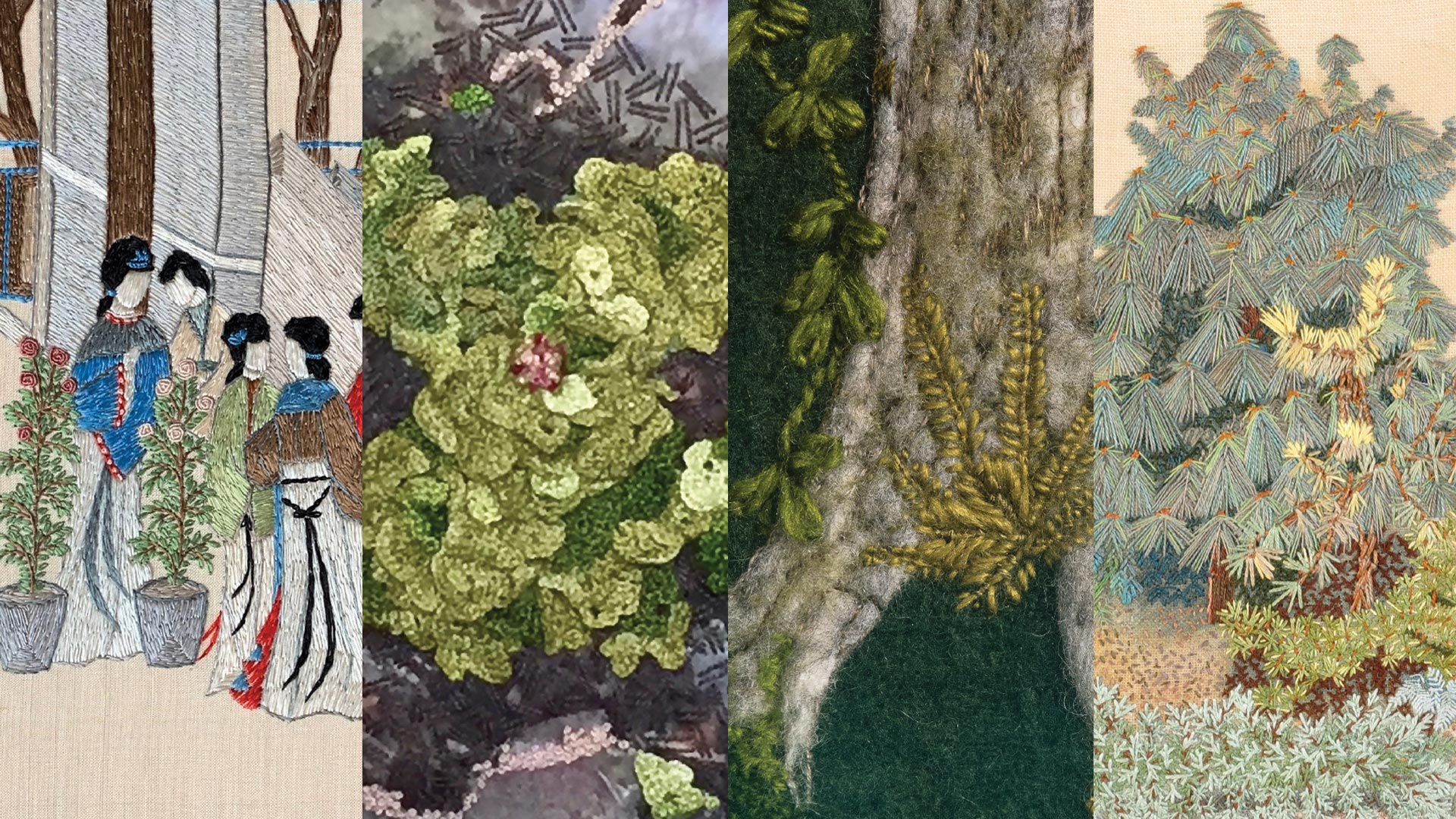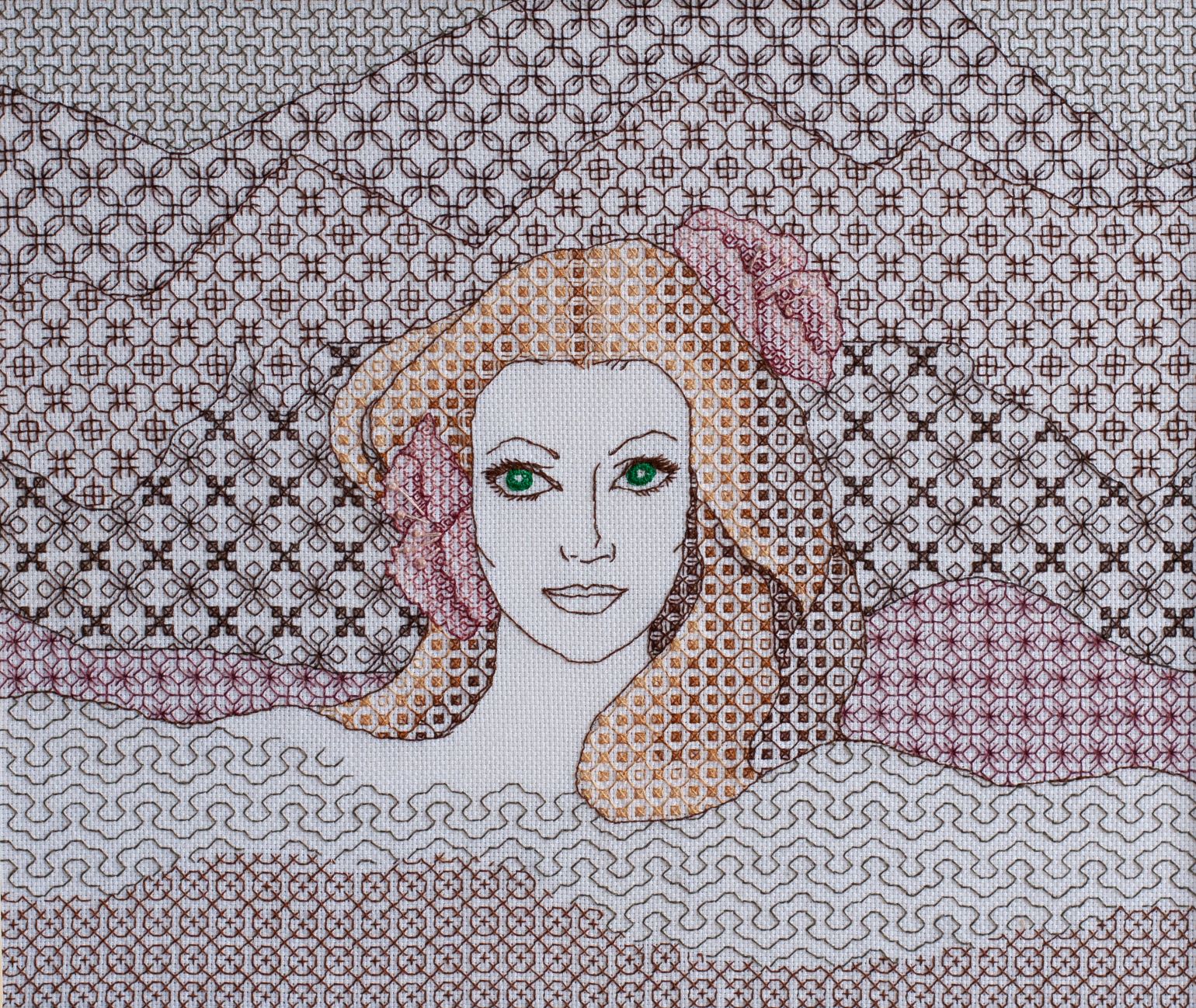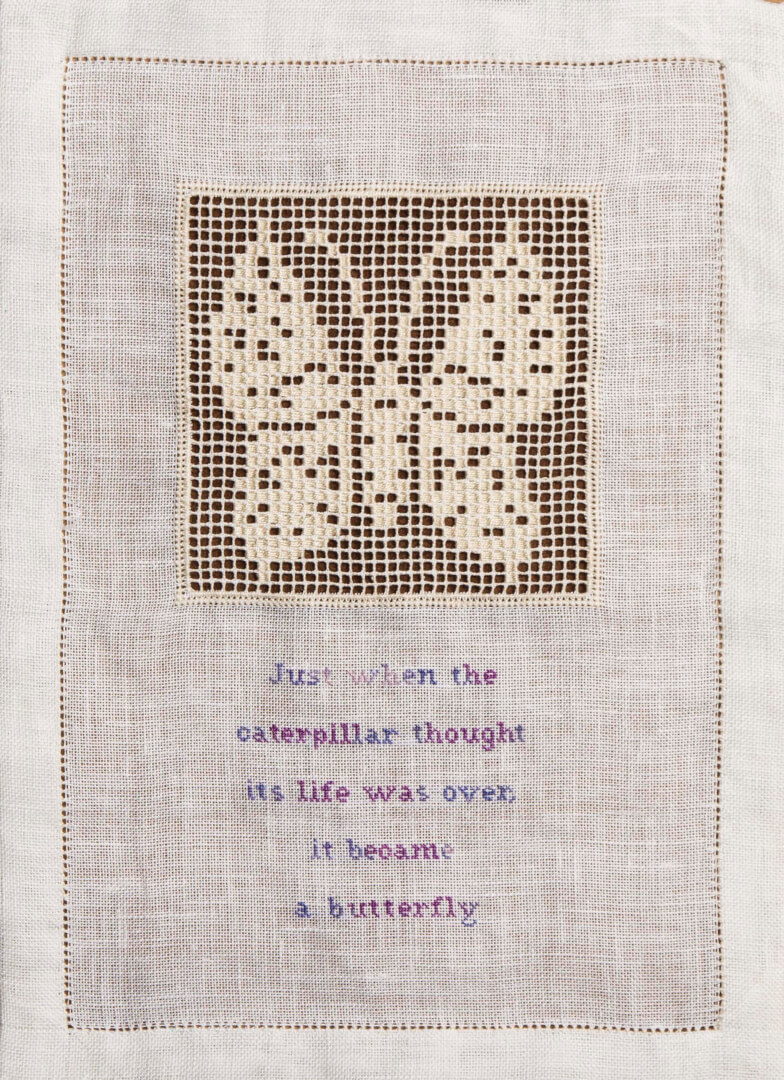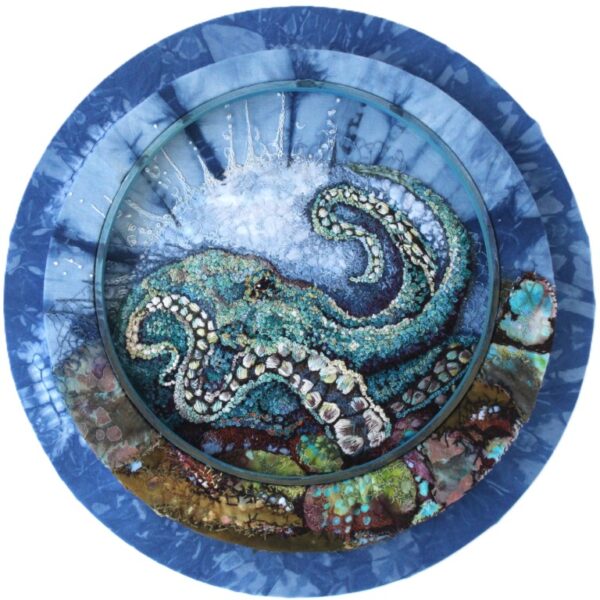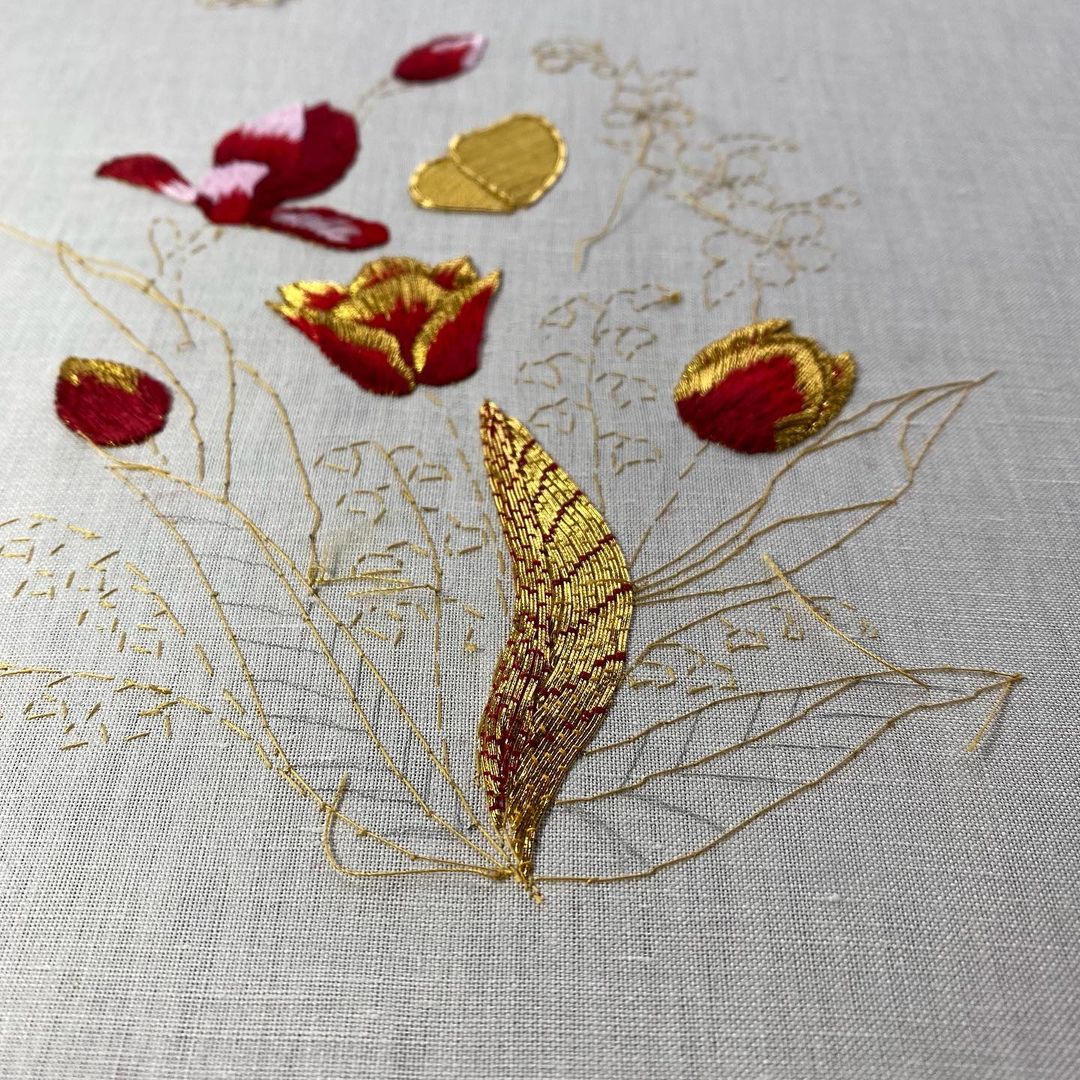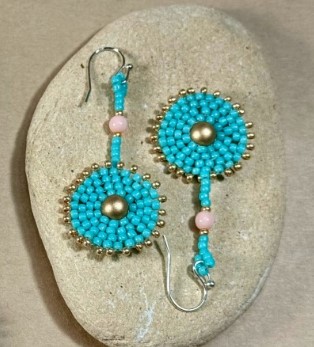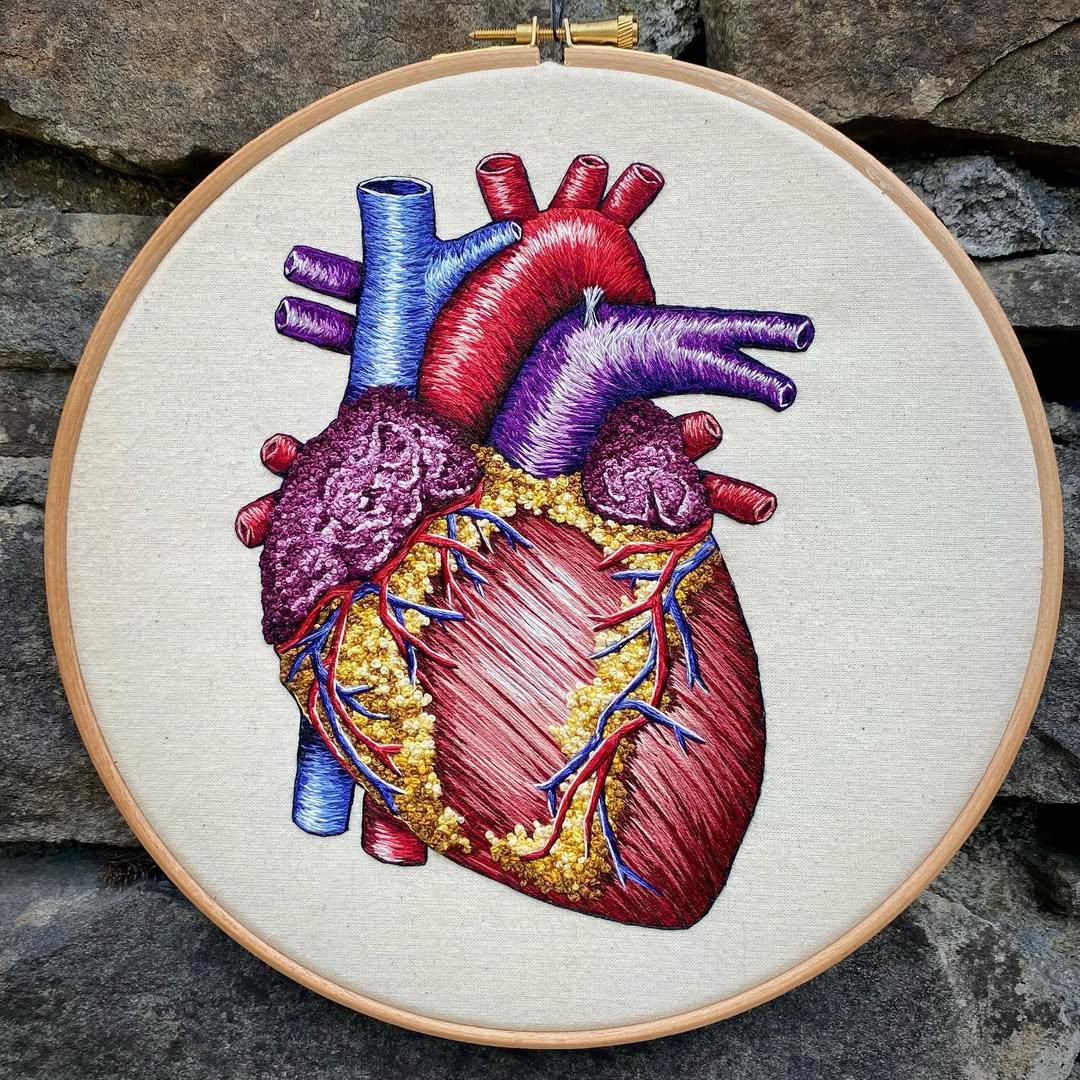
This month EGA was delighted to sit down with Cath Janes, an artist who specializes in a particularly revealing style of needlework: anatomical embroidery. An affiliate member of the Institute of Medical Illustration, Janes has received multiple awards for her work. Her embroidery will be exhibited at The Broderers’ Exhibition 2025: The Art of Embroidery at the Bankside Gallery in London from February 25 to March 2, 2025. Like many artists, Janes’ work as an anatomical embroidery artist flourished from a desire to reflect her own life experiences. She now creates high-quality prints and stickers from her anatomical embroideries, and receives commissions from the medical community and art enthusiasts alike.
How were you introduced to embroidery? Where did your passion for embroidery and needlework begin?
Until I was in my 40s, I hadn’t touched an embroidery needle since my schooldays, when I’d been forced to decorate oven gloves by a teacher. I hadn’t given it a second thought, being taken up instead with my career in journalism. So it wasn’t until I underwent a series of surgeries for my facial paralysis that my interest in embroidery really began. During one particularly boring period of recovery, I had the urge to embroider and asked my husband to bring some fabric scraps and a needle and thread to my hospital bed just to allow me to noodle. At that stage it felt entirely meditative and it allowed me to be mentally busy while physically resting. I had no idea what it would become ten years later!
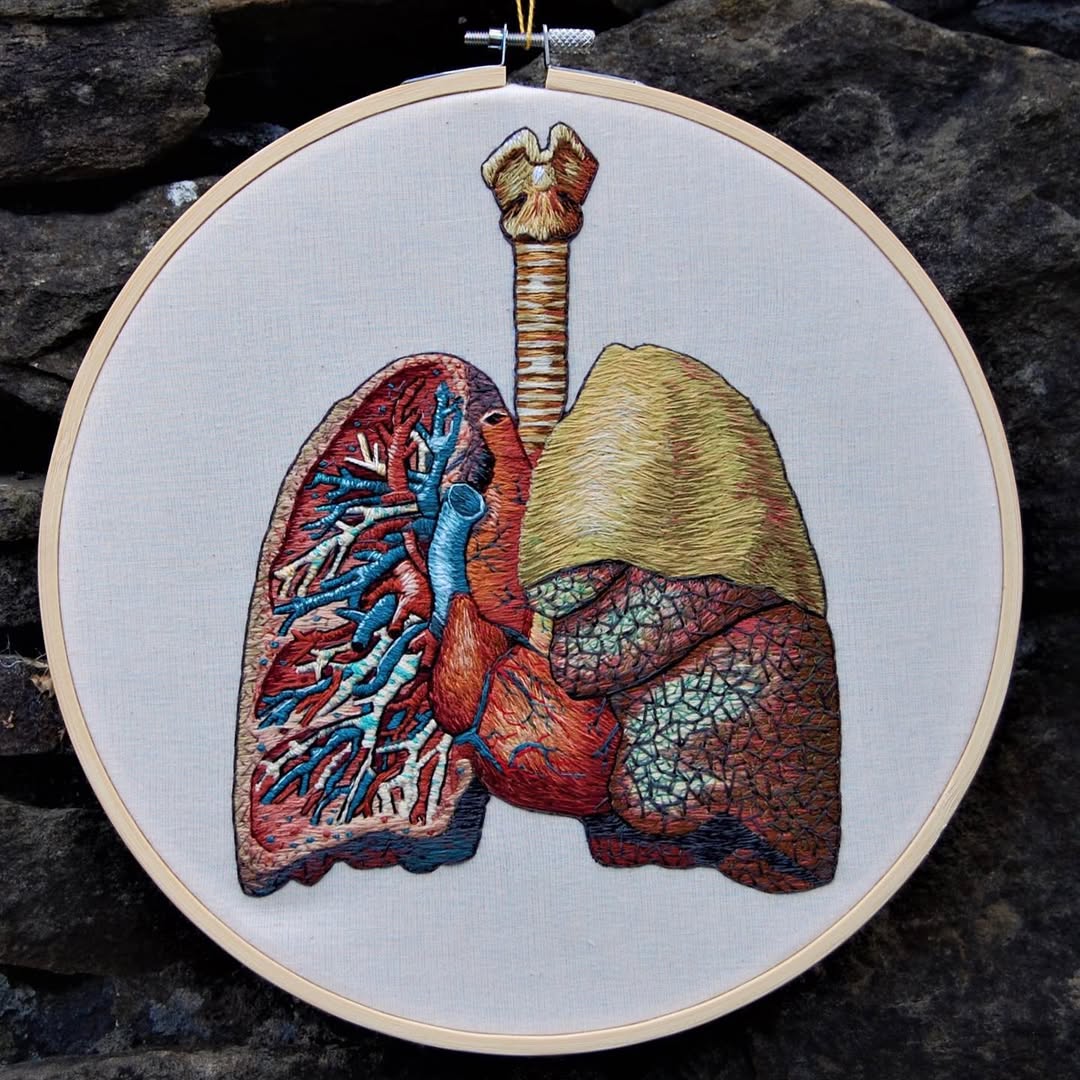
What drew you to anatomical embroidery?
My surgeries meant taking a very deep dive into my own anatomy so I became well acquainted with anatomical structures such as muscles and blood vessels. I realized, during my noodling stage, that straight stitches looked a lot like muscle fibres and I wondered if I could replicate them. I had a vague interest in anatomy anyway, and could never resist falling down new rabbit holes, so I found an image of the facial anatomy and started stitching it. It felt very odd—I seriously believed back then that embroidery was only used for floral designs and landscapes—but I loved it. When I showed my half-completed piece to my facial surgeon he leapt out of his chair with excitement and offered to buy it upon completion. That’s when I knew I was onto something. Not bad for a woman who failed both biology and art exams at school.
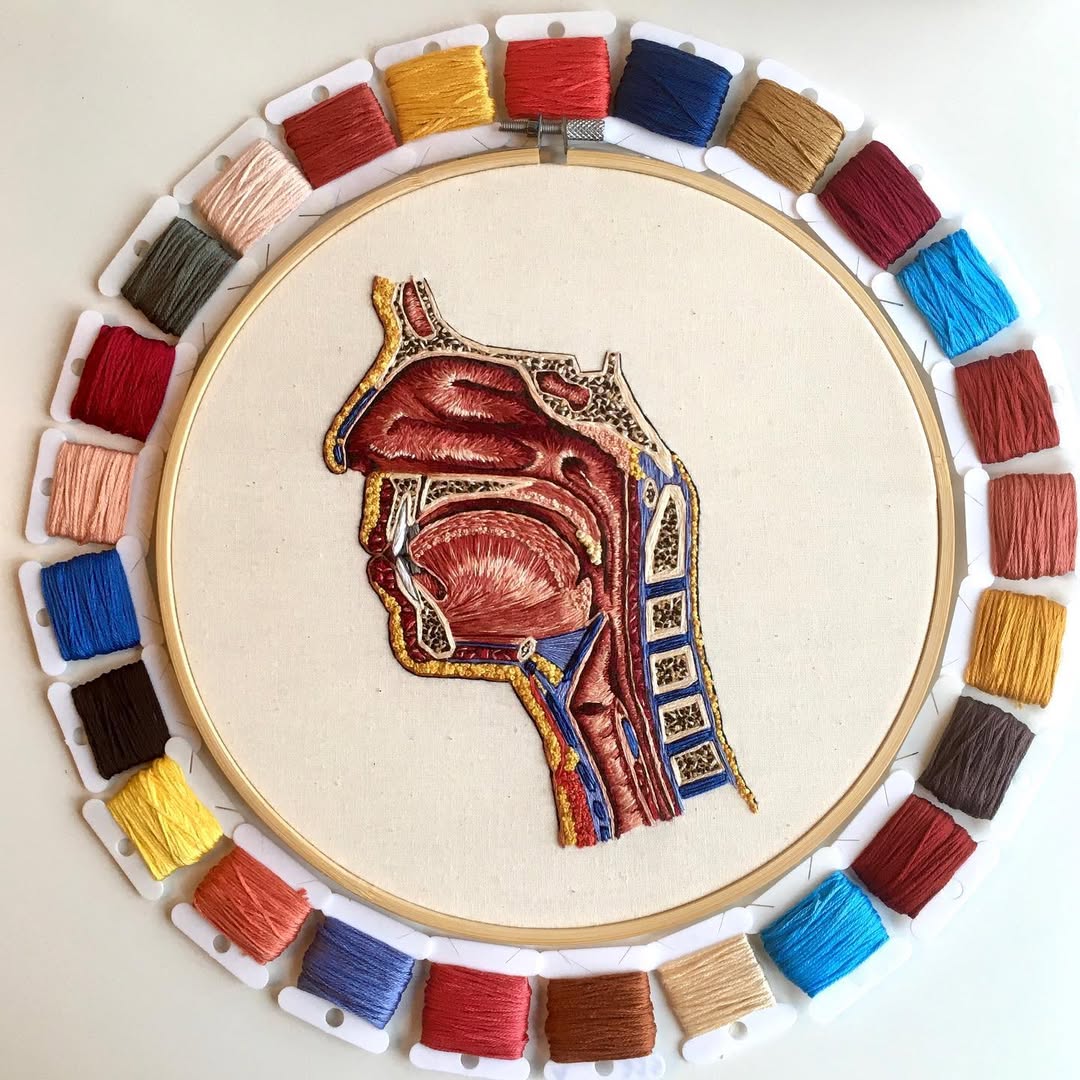
Where do you find design inspiration? What does your design process look like?
My medical illustrations begin with me rummaging through my anatomy text books and doing my own dissections (on animal specimens from medical services or even fresh roadkill). I look for an anatomical structure that intrigues me enough that I’d happy spending months stitching it. Then I research that structure to the nth degree. I’d never copy someone else’s anatomical illustration so prefer to create my own rendering. It’s not easy because I have zero anatomical training but always worth it to create my own take. I do, though, live in terror of being told by an anatomy expert that I have missed a detail though that hasn’t happened yet.
I also gravitate towards images that allow me to play with color. Traditionally, medical illustrations use false color because that helps anatomy students learn the various structures. Yellow is used for nerves, blue and red for blood vessels, for example. I tend to create images that include these because I can play with color more and it is more interesting for the viewer too. If I were to stitch realistic anatomical shades I’d be stuck with nothing but dullish pinks, browns and greys. Our anatomies are the most fascinating things in the world but in terms of color there’s not a lot going on.
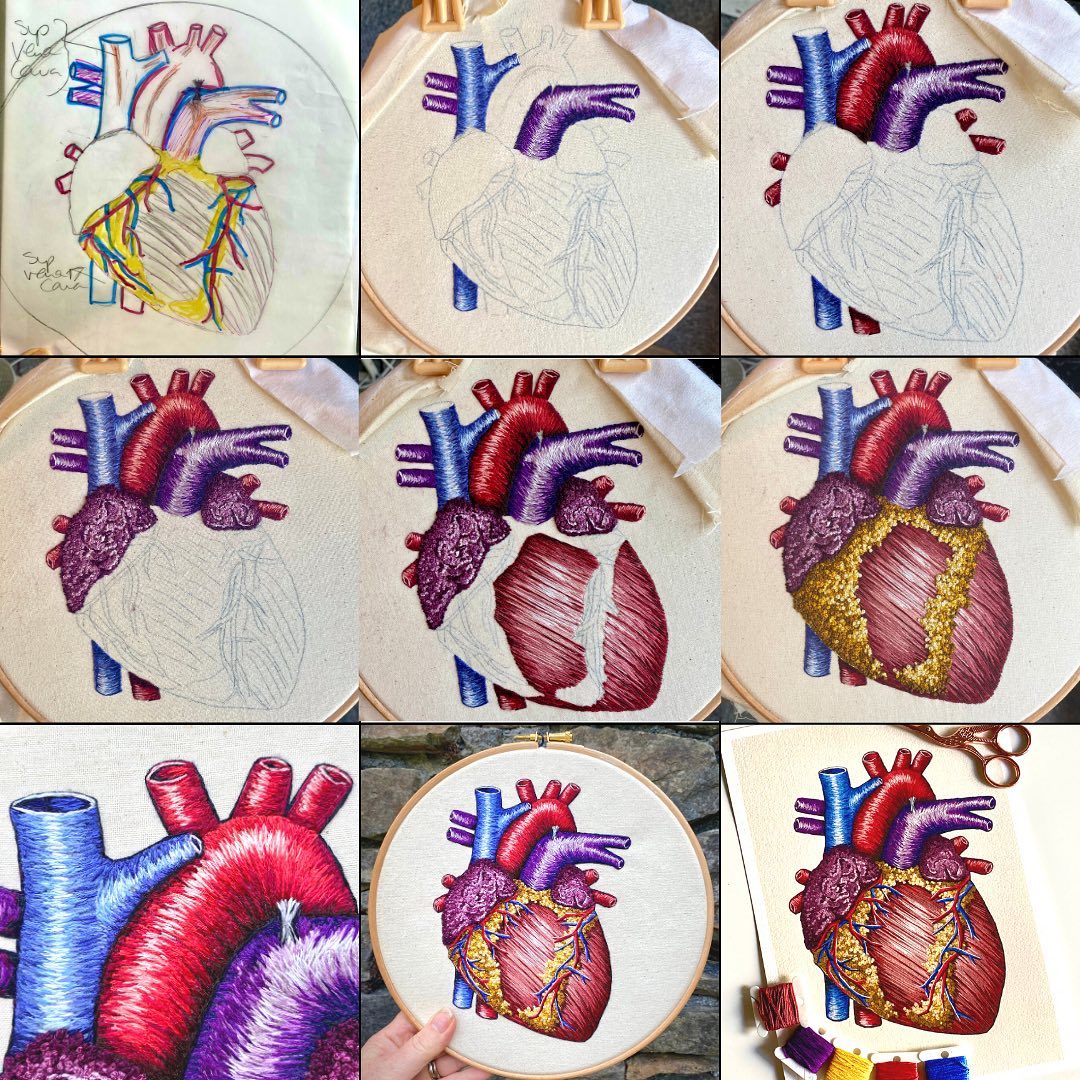
How long does it take you to complete an anatomical embroidery?
If it’s on a 12-inch hoop a piece can take up to three months. It really does depend on the complexity of the anatomical structures though. A piece with lots of nerves and blood vessels can take an extremely long time, not least because I’m a bit obsessive about stitch direction. I’ll make hundreds of two-millimeter long stitches in varying shades just to capture the curve of an artery, for example. Last year I started working on a range of pieces focusing on my experience of birth trauma and they take a lot longer. My current piece, which is approx 60x60cms, will have been on my frame for a full year by the time it’s completed and during that period I won’t have worked on anything else. It really is the long game. I don’t know why I do it to myself, frankly. I crave the dopamine hits of completing pieces so there are weeks when these large pieces feel like torture.
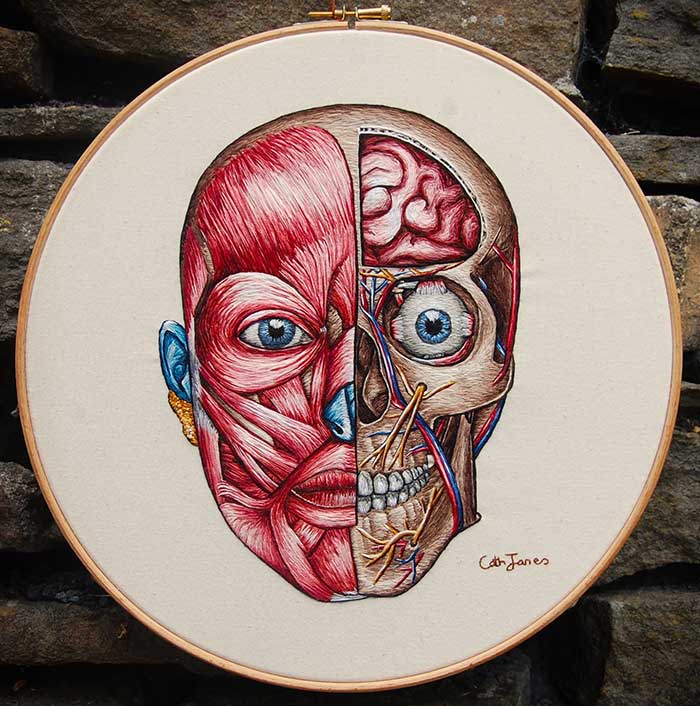
Your pieces feature impressive depths of color accomplished with what looks like the thread painting technique. As a self taught embroidery artist, how do you approach color, color blending, and capturing light and shadow?
As I explained above, I gravitate towards the false color of anatomical illustration where I can just to keep me, and viewers, interested. I now have a box of threads solely for coloring blood vessels, nerves, and adipose fat. When I start stitching a section I do it much in the way I used to paint with acrylics many years ago: blocking in areas then refining until I get the detail I want. I’ll build the range of shades I want to use (anything up to 20 for even the smallest areas) and I fill in the dark, light and medium shades first, usually with two strands. Then I start overlaying the shades that help those ‘extremes’ blend into each other. I do this with single strands which is time consuming but I just can’t seem to stop myself because I love the effect of it. I’ve even attempted to split a single strand and that’s usually when I have a stern word with myself and leave my studio for some fresh air. Of course, this can all bite me when I’ve overlaid so many stitches that I can barely pierce my fabric. One kind fan of my work, however, sent me a pair of surgical forceps and that’s a brilliant piece of kit for wiggling the needle through the fabric.
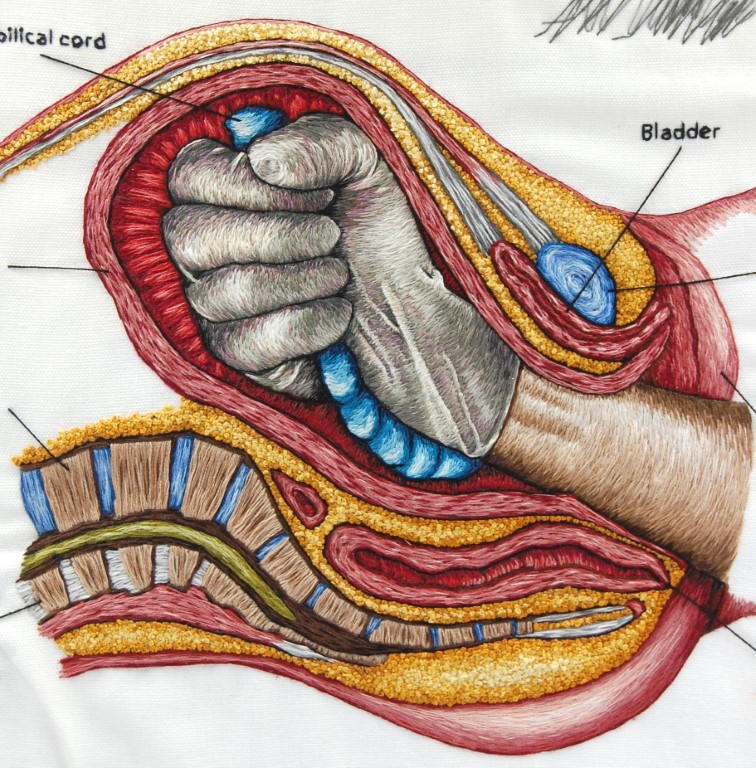
Do you have a favorite anatomical embroidery piece? Why is it your favorite?
It is a cliche to say my latest one? Probably. Right now I’m insanely proud of the pieces I’m stitching about my birth trauma. It was a devastating experience that left me with severe post natal depression and PTSD and creating art around that has been deeply therapeutic as well as a huge technical and artistic challenge. I’m loving it even though there are days when it’s like staring down the barrel of a gun and I’m left in tears by it. I’m also deeply proud of the impact these pieces are having on other survivors of birth trauma. I’ve been deluged with messages from women who want to tell me their own stories often after decades of silence. What an honor!
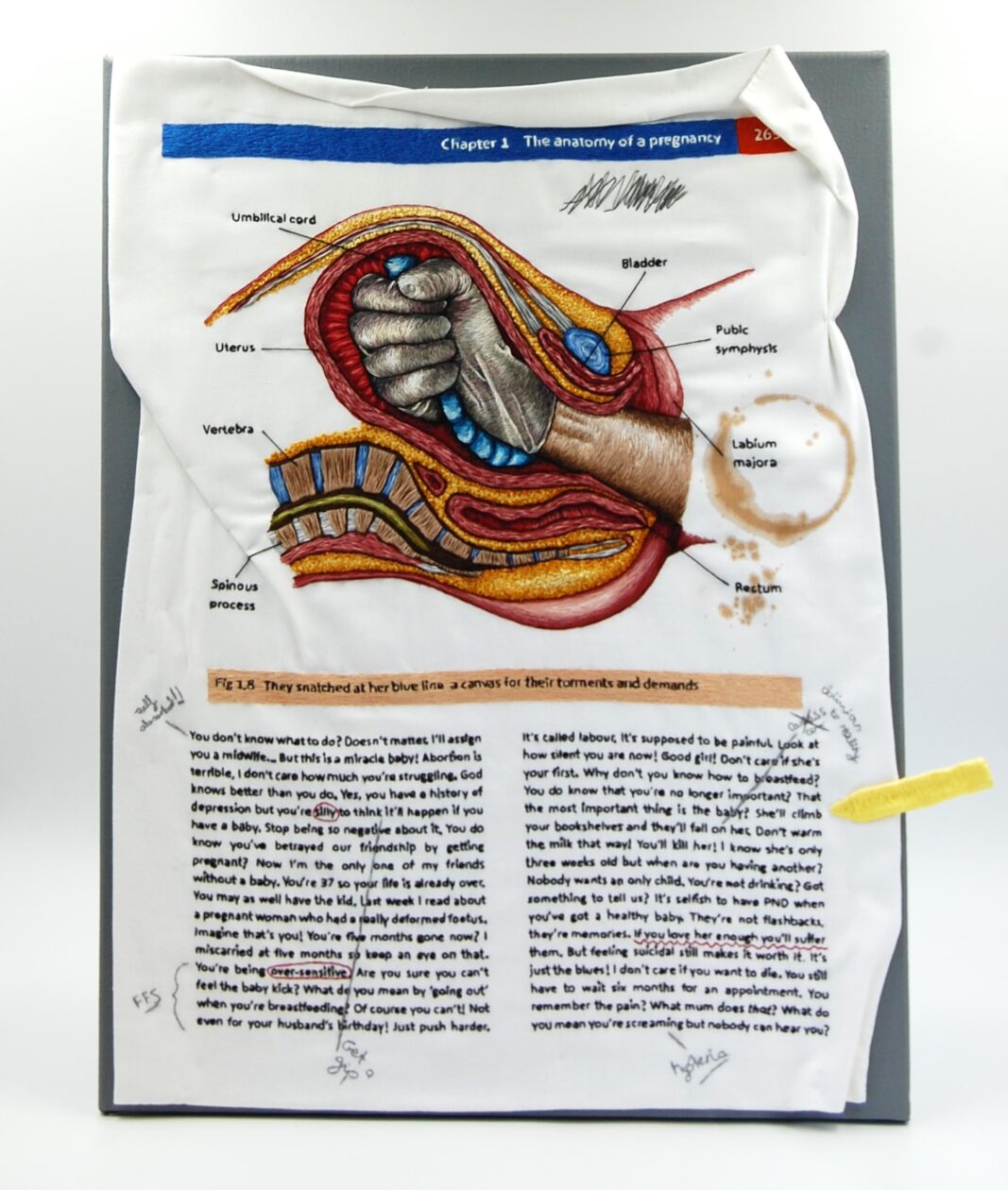
As for strictly anatomical illustrations, I love my piece of a baby in-utero. While I happily accepted the commission I dreaded stitching it because I was scared of the challenge of replicating a baby. Yet it was also the moment when I realized that I could go beyond anatomical illustrations and try more artistic pieces such as those of my birth trauma art. I’m also proud of My Black Eye, my rendering of the black eye I developed after more facial surgery last year. That felt like a huge color challenge but it was so different to my other work that I threw myself in. Embedding the suture needle and thread in it was huge fun too.
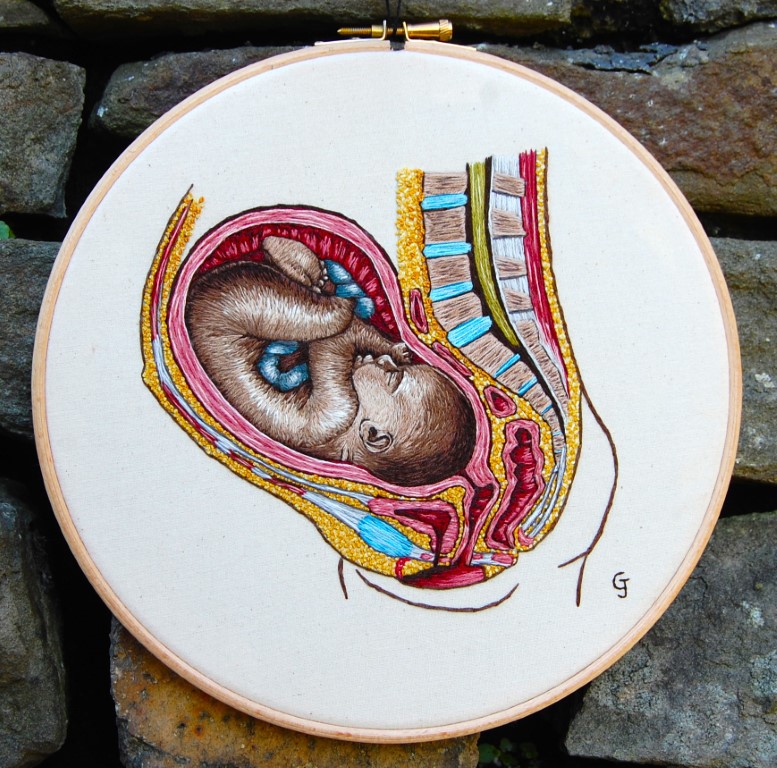
Do you have any favorite tools you can’t live without?
My massive Frankensteinian frame. I bought an old second hand stand frame online and set about tweaking it so that it would hold my huge embroideries. I bought and doctored tree stakes to replace the scroll bars making it a whopping 1.5 metres long. Then, because I hate sitting to stitch, I’ve cobbled together a system which allows me to stand when I work. The frame is now eye height, perched on boxes of stored fabric and locked in place with clamps. It’s far from pretty but it’s doing a most excellent job. As for my other kit, I use DMC or Anchor threads, any sharp needle (I’m not remotely fussy about those) and leather thimbles for when my stitching is so dense that the eye of the needle keeps piercing my fingertips.
View this post on Instagram
Do you have a daily or weekly needlework practice? What does that look like?
I do 9-5 hours three days a week. I used to do five days a week but I’m trying to find a better balance not least because this started to feel really isolating. On the two weekdays I don’t stitch I get out of my studio to do random textile art with a local group or at least activities that allow my mind to wander. I may sneak away from family and into my studio at other times but usually, after a full day of stitching, I’m seeing stars and ready for a break. I’ll listen to podcasts when I stitch, unless I get to a tricky area when I need silence to focus. I’ve tried listening to music too, but I’m a massive fan of deep house and trance and keeping still while listening to it is impossible.
Long stitching sessions can play havoc with my body though. Even standing all day rather than sitting, my back begins to ache so my practice now includes cardio workouts and weight training. I used to see exercise as separate from my stitching but now I can see it’s part of my stitching. If I stitched like this without looking after my body I’d not be able to keep going. I often laugh when people tell me they think embroidery is a delicate artform because I see dissections and weight lifting as much as I see needles and thread.
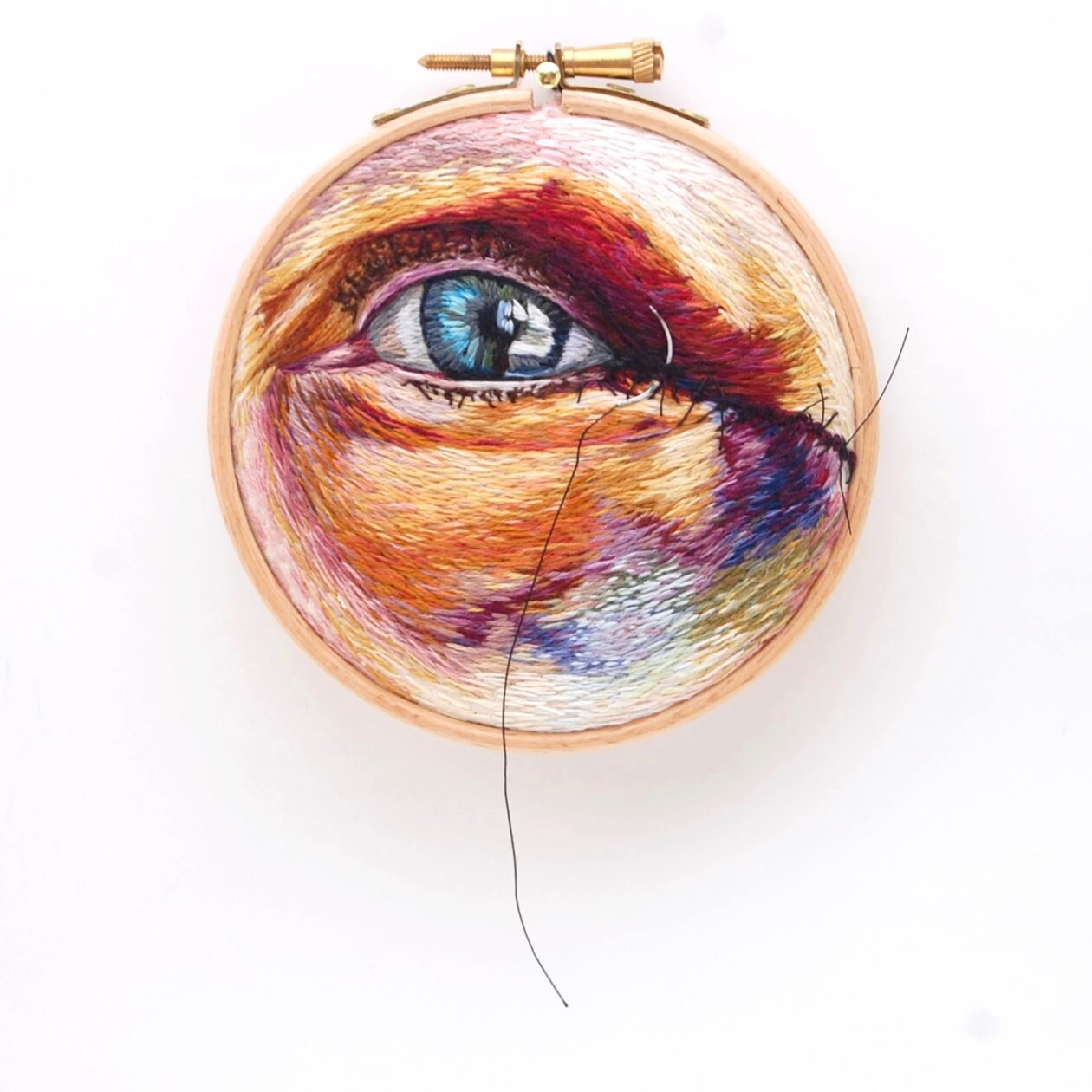
Do you have any fun upcoming or ongoing projects or events you’d like to share with EGA’s audience?
My birth trauma work is exciting me beyond all measure at the moment. My first large piece, Torments and Demands, is being shown at a prestigious embroidery exhibition in London in February and that’s still blowing my mind. It’s rare that birth trauma art is seen anywhere, let alone as an embroidery, so I can’t wait to see the reactions of viewers and to be among so many other brilliant embroidery artists. With my birth trauma art I feel as if I’ve leaped off a cliff without knowing where I’ll land. It was terrifying at first but now I’m enjoying the falling. For the first time in my life I have no artistic boundaries (I’m no longer constrained by anatomical precision, for example) so every day is its own little adventure.
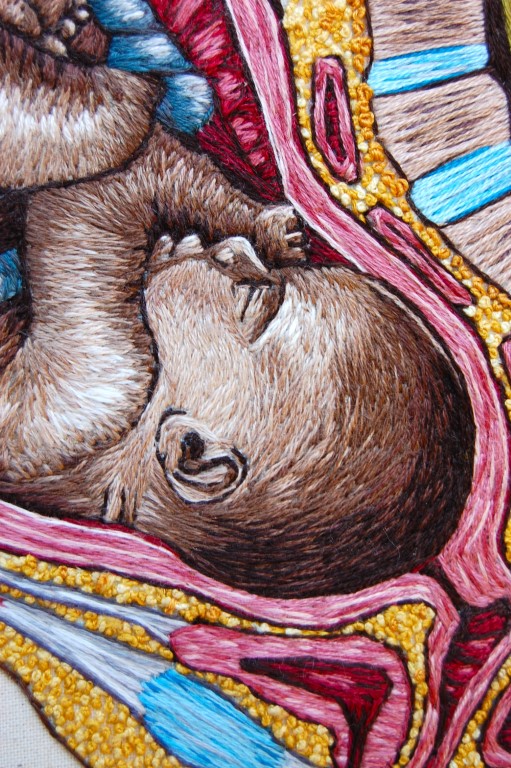
Where can EGA’s readers follow you on social media and learn more about your work?
Readers can check out my work at cathjanes.com but for the real blow-by-blow details they can find me @cathjanesanatomy on Instagram. That’s where I put all the completed stages of my work and my behind-the-scenes processes almost daily along with whatever else is going on. It’s huge fun. I see instagram as part of my creative output so anyone who wants to join in is more than welcome.
